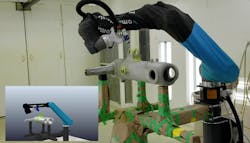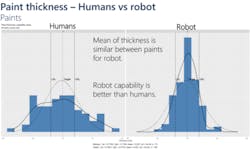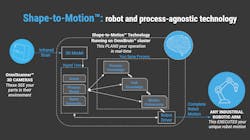What is the real value of autonomous manufacturing robots?
Unmanned Autonomous Vehicles have attracted plenty of interest front the aerospace industry, and the long tradition of autopilot systems has led the way for machine control of everyday essential services.
While aerospace technology and equipment has been a global technology leader for decades, manufacturing processes inside the aerospace industry have sometimes lagged behind. This is generally because aerospace manufacturing and MRO firms generally function in a “high-mix, low-volume” format. They produce a relatively small amount of goods compared to mass manufacturers, but those goods offer tremendous value and often require frequent changeover in order to get the job done.
This method of work often involves high quality expectations, frequent rework and deals with hazardous or expensive materials where waste must be minimized to maintain profitability. And yet, industrial automation has rarely made its way to the aerospace factory floor. With autonomous manufacturing robots, however, the ability of a robot to finally see, plan and execute processes without the need for programming or jigging expenses can fundamentally transform the way aerospace manufacturers look at their operations.
Greater Process Efficiency
First and foremost among the value presented by such a solution is the ability to actually perceive and generate a motion program within process constraints. This can be achieved for processes ranging from welding, machining, coating, abrasive spray processes and contact finishing. As of today, Omnirobotic’s Shape-to-Motion ™ Technology is one example of this capability and currently supports all spray processes - everything from painting to sandblasting and shot-peening.
By being able to generate their own motions and toolpaths from process constraints and more, autonomous manufacturing robots, these robots are able to respond to any part shape and position in real process time. This eliminates the manual programming and jigging requirements that have made changeover impossible to manage for traditional robots within the aerospace sector.
By getting over this constraint, aerospace manufacturers can finally access the benefits of robotics without their incremental costs. This means 20-30% savings on consumables and energy waste, as well as 30-40% productivity improvements over existing workflows, reduction of rework to practically zero, and again zero incremental costs from a robot when scaling operations to a second or third shift.
By using a scanning system, 3D modelling libraries and the ability to prioritize between primitive tasks and process constraints, autonomous robots can finally optimize value-added processes without introducing incremental costs for each part.Elimination of Bottlenecks
Within aerospace manufacturing, rework is most often the core source of added costs above the standard processes used. In some cases, significant rework can be required for up to 50% of parts processed, and processes may be expanded and multiplied in order to minimize rework, but do so at great cost and organizational complexity.
Ultimately, this creates a bottleneck where precision and quality is required, and spray processes are first among these. Robots are generally known for their efficiency and precision, but by eliminating their constraints around high-mix environments, aerospace manufacturers can dig down and identify where their processes are really failing and ultimately cramping the bottom line or reducing responsiveness to last-minute client orders.
Data from an internal study at an aerospace manufacturer. By introducing robotic precision without part changeover limitations, autonomous robots can constitute a great leap forward for value-added manufacturing processes.
Bringing Flexibility to Skilled Workforce
The final effect that comes with elimination of bottlenecks is increased flexibility within the workforce. Flexibility is of course introduced by decreasing the need for highly-skilled and experienced workers to accomplish quality goals on particularly tedious processes. Flexibility is also increased when these workers no longer face the health hazards and pains that may come with working in a paint booth and can instead act as operators providing instructions and oversight to a robot.
Flexibility also comes in adding bandwidth and capacity to a finishing operation without added incremental costs. With autonomous robotic systems, aerospace manufacturers can avoid the risks of an aging workforce where knowledge transfer is not realized and there aren’t enough young workers to replace retiring baby boomers.As Deloitte has reported, there will be 2.4 million unfilled skilled positions in US Manufacturing by 2030 - a challenge that is both being exacerbated by the COVID crisis and will be particularly difficult to manage as the business cycle again picks up, but few workers rush to manufacturing to replace them without highly attractive compensation and benefits.
An autonomous manufacturing robot is seen processing an aerospace part. By being able to interpret and validate motions for complex shapes in real process time, autonomous robots limit operators to get more done.
With Autonomous Manufacturing technology at their disposal, aerospace manufacturers will finally be able to realize greater efficiency for a variety of processes. When it comes to the process costs associated with their high-value hardware, however, one can hope that this technology doesn’t just introduce the same efficiency that autopilot and UAVs add to flying experiences, but make flying a more accessible and frequent experience for all.
Robert Ravensbergen is the Marketing Director at Omnirobotic, the only provider of autonomous robotics technology for industrial spray processes. You can reach Omnirobotic at [email protected] or visit https://omnirobotic.com/.


